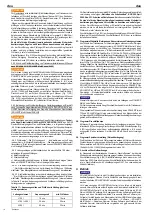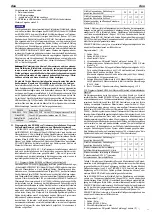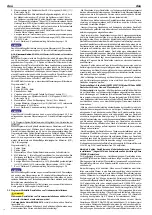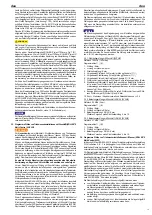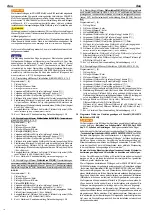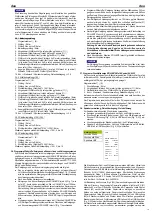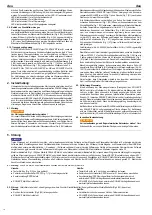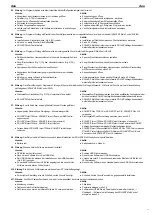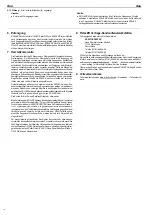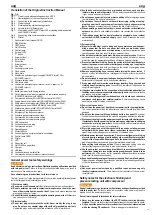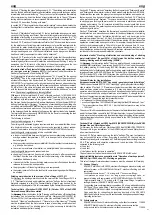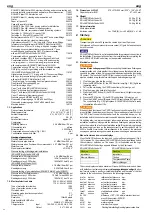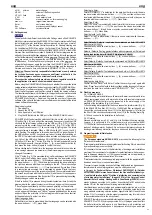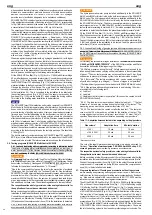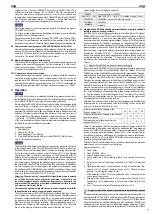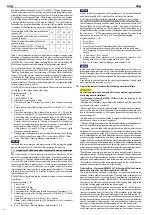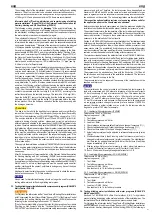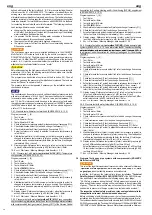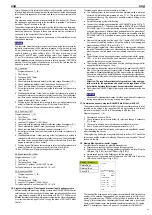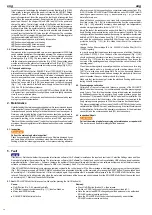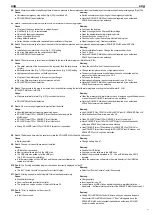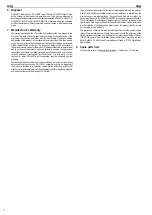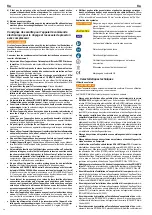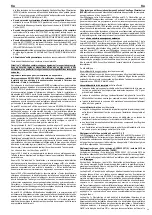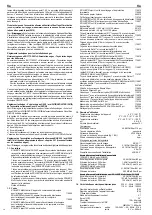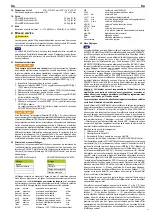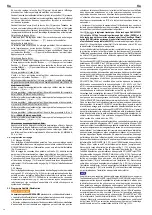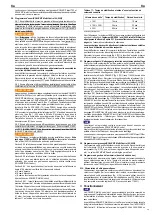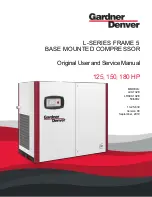
eng eng
when used and therefore forms no critical decomposition products and can be
drained into sewers without problems because of its rapid decomposition.
Besides, the concentration of ROLLER’S Plus TW-D with 1.5 % hydrogen
peroxide is not classifi ed as dangerous (not a hazardous substance).
ROLLER’S Plus TW-D consists of a watery solution hydrogen peroxide corresponding
to the application concentration of the dosing solution of 1.5 % H
2
to the application concentration of the dosing solution of 1.5 % H
to the application concentration of the dosing solution of 1.5 % H O
2
, corresponding
to 15 g/l H
2
to 15 g/l H
to 15 g/l H O
2
recommended in the named rules. When diluted with 100 l of water
22
a concentration of the disinfection solution of 150 mg H
2
a concentration of the disinfection solution of 150 mg H
a concentration of the disinfection solution of 150 mg H O
2
/l results.
22
The advantage of the concentration of the dosing solution chosen by ROLLER’S
f t
f t
is also that the user gets a ready to use dosing solution which is not a hazardous
substance. Nevertheless, the safety data sheets for ROLLER’S Plus TW-D and
ROLLER’S Color under www.albert-roller.de → Downloads → Safety data
sheets as well as other local and national regulations must be observed. Every
ROLLER’S Plus TW-D dosing solution comes with a ROLLER’S Color dye that
is not harmful to the health which is mixed with the dosing solution immediately
before the disinfection process and dyes this. This enables a simple check
whether the disinfection solution has entered the drinking water installation and
whether it has been fl ushed out completely at the end of disinfection. The
contents of a 1 l bottle of dosing solution suffi ces for disinfection of a section
with a volume of approx. 100 l.
We advise against buying disinfectants, e.g. hydrogen peroxideH
We advise against buying disinfectant
We advise against buying disinfectant
2
s, e.g. hydrogen peroxideH
s, e.g. hydrogen peroxideH O
2
, with higher
concentrations which the user then has to dilute to the recommended concen-
tration of the dosing solution. Such actions are dangerous due to the higher
concentrations of the disinfectants so that hazardous substance and chemical
prohibition directives and possibly other national laws must be observed. In
addition, errors in the preparation of the self-mixed dosing solution can cause
harm to persons and damage to the drinking water installation.
Fit the ROLLER’S fi ne fi lter (Fig. 3 (12)) (Art. No. 115609) with fi lter cartridge
Fit the ROLLER’S fi ne fi
Fit the ROLLER’S fi ne fi
90 µm after the house connection (water meter). Connect the suction/pressure
hose (Fig. 1 (13)) to the fl ushing supply (14) before or after the fi ne fi lter. Fit
the ROLLER’S Inject TW with supply (Fig. 7 (16)) disinfection unit for drinking
water installations to the fl ushing drain of ROLLER’S Multi-Control (Fig. 4 (15)).
Observe the direction of fl ow arrows. The main line of the disinfection unit
Observe the direction of fl ow arrow
Observe the direction of fl ow arrow
consists of the supply, pressure limiting valve (17), non-return valve (18), drain
to the installation (19). This is connected to the installation to be infected by
the suction/pressure hose (Fig. 4 (13)). Part of the supply is pressed by the
fl ow head (Fig. 7 (20)) into the bottle (21) which contains the dosing solution.
This is fed to the drinking water installation to be disinfected.
NOTICE
NOTICE
The ROLLER’S Inject TW disinfection unit must be removed from ROLLER’S
Multi-Control to fl ush drinking water pipes after disinfection. Suction/pressure
hoses used for disinfection should be fl ushed thoroughly before using for
pressure testing of drinking water pipes. Hydrogen peroxide decomposes in
time and loses its effect depending on the environment in which it is stored.
Therefore the concentration of the dosing solution should be checked for
effectiveness before every disinfection. To do this, fi ll a clean, sealable container
with 100 ml of water and draw 1 ml of dosing solution from the bottle using the
pipette provided with every carton of ROLLER’S Plus TW-D Color and add it
to the container (ratio 1:100). Seal the container and shake well. The concen-
tration of the container contents is measured with the test strip (Art. No. 091072)
according to the instructions printed on the test strip package. This should be
≥ 150 mg/l H
2
O
2
.
The built-in nozzles for automatic dosing by ROLLER’S Inject TW and ROLL-
ER’S Inject H are different and are adapted to the properties of the ROLLER
ingredients to be injected. Therefore please always observe the intended use.
2.6. Testing programs (ROLLER’S Multi-Control SL/SLW)
2.6.1. Leak and load testing with compressed air according to information leafl et
2.6.1. Leak and load testing with compressed air according to information leafl et
"Leak tests of drinking water installations with compressed air, inert gas or
"Leak tests of drinking water installations with compressed air, inert gas or
water" (January 2011) of the German Central Association for Sanitary, Heating
water" (January 2011) of the German Central Association for Sanitary, Heating
and Air Conditioning (ZVSHK)
and Air Conditioning (ZVSHK) (ROLLER’S Multi-Control SL/SLW)
(ROLLER’S Multi-Control SL/SLW)
WARNING
WARNING
For
Germany
Germany the information leafl et "Leak Tests of Drinking Water Installations
Germany
Germany
with Compressed Air, Inert Gas or Water" (January 2011)
(January 2011) of the German Central
Association for Sanitary, Heating and Air Conditioning (ZVSHK)
(ZVSHK) defi nes the
following for the national regulations under "3.1 General":
"Due to the compressibility of gases, the rules for the prevention of accidents
ases, the r
ases, the r
"Working on Gas Systems" and the "Technical Rules for Gas Installations
DVGW-TRGI" must be observed for physical and safety reasons when conducting
pressure tests with air Therefore, the test pressures have been defi ned as
maximum 0.3 MPa/3 bar/43.5 psi, the same as for load and leak tests for gas
pipes, in agreement with the responsible industrial liability insurance associa-
tion and based on these rules. The national regulat
tion and based on these rules. The national
tion and based on these rules. The national
ions are thereby fulfi lled.“
regulat
regulat
The respective national safety provisions, rules and regulations valid for
the application site must be considered and observed.
Before conducting a test with compressed air, it must be assessed whether the
installation to be tested will withstand the preset / selected test pressure "p refer".
Connect the compressed air hose (Fig. 4 (23)) to the output Pressure test with
compressed air, Disinfection, Cleaning, Preservation, Compressed air pump
(22) and connect the compressed air hose (23) to the installation to be tested.
2.6.2. Pressure and leak testing of drinking water installations with water in
2.6.2. Pressure and leak testing of drinking water installations with water in
accordance with EN 806-4:2010 (ROLLER’S Multi-Con
accordance with EN 806-4:2010 (ROLLER’S Multi-Control SLW)
trol SLW)
WARNING
WARNING
The hydro-pneumatic water pump installed additionally in the ROLLER’S
Multi-Control SLW for this test is fed by the built-in compressor of the ROLLER’S
Multi-Control. The hydro-pneumatic water pump installed additionally in the
ROLLER’S Multi-Control SLW for this test is fed by the built-in compressor of
the ROLLER’S Multi-Control. The hydro-pneumatic water pump generates a
water pressure of max. 1.8 MPa/18 bar/261 psi. Before conducting one of the
tests with water according to method A, B, C, it must be assessed whether the
installation to be tested will withstand the preset/selected test pressure "p r
installation to be tested will withstand the preset/selected test pressur
installation to be tested will withstand the preset/selected test pressur
efer".
e "p r
e "p r
Fit the ROLLER’S fi ne fi lter (12) (Art. No. 115609) with fi lter cartridge 90 µm
after the house connection (water meter). Connect the suction/pressure hose
(13) to the pressure test with water supply (Fig. 1 (24)) after the fi ne fi lter.
Connect the high-pressure hose (26) to the pressure test with water drain (Fig.
4 (25)) and connect to the installation to be tested. Feed the pressure relief
water drain (27) into a vessel (bucket).
2.6.3. Load and leak testing of gas pipe systems with compressed air in accord-
2.6.3. Load and leak testing of gas pipe systems with compressed air in accord-
ance with "Technical Rule Worksheet G 600 April
ance with "Technical Rule Worksheet G 600 April 2018 DVGW-TRGI
2018
2018
2018" of
the DVGW German Gas and Water Association, Germany
the DVGW German Gas and Water Association, Germany (ROLLER’S Multi-
(ROLLER’S Multi-
Control SL/SLW)
Control SL/SLW)
WARNING
WARNING
For Germany, the technical rule for gas installations
"Technical Rule Worksheet
G 600 April 2018 DVGW-TRGI
2018
2018
2018" of the DVGW German Gas and Water
Association defi nes the following among other things:
"5.6.2 Safety measures during the tests": Safety measures may need to be
taken during the tests when carrying out the load test due to the compressibility
of gases. "The max. test pressure may not exceed the value of 3 bar. Every
sudden rise in pressure in the pipe system to be tested must be avoided."
"5.6.3 Test media": "The tests in accordance with ... can be carried out option-
ally with air or inert gas (e.g. nitrogen). …The use of oxygen is not permitted."
(The test with inert gases cannot be carried out with ROLLER’S Multi-Control).
"5.6.4 Pipe systems with operating pressures up to and including 100 mbar ...
are subjected to the following tests:
a) Load test
b) Leak test
c) Usefulness test for systems in operation" (this cannot be carried out with
ROLLER’S Multi-Control).
"5.6.4.1 The load test must be carried out before the leak test …" "The test
pressure is 1 bar and may not drop during the test time of 10 minutes." "The
measuring device must have a minimum resolution of 0.1 bar".
"5.6.4.2 The leak test must be carried out after the load test..." The test pres-
sure must be 150 mbar and may not drop for the duration of the test.“ The
measuring device must have a minimum resolution of 0.1 mbar. Table 11
specifi es "Adaptation times and test duration depending on pipe volume":
Table 11 – Adaptation times and test duration depending on the pipe volume
Pipe volume*
Adaptation time
Min. test duration
< 100 l
10 min
10 min
≤ 100 l < 200 l
30 min
20 min
≤ 200 l
60 min
30 min
*Recommended values
This rule of the legal German accident insurance must also be observed for
Germany.
"Operation of work equipment", BGR 500, April 2008, chap. 2.31,
Work on gas pipes, industrial liability insurance association rule.
The respective national safety provisions, rules and regulations valid for
the application site must be considered and observed.
Before conducting a test with compressed air, it must be assessed whether the
installation to be tested will withstand the preset / selected test pressure "p refer".
Connect the compressed air hose (Fig. 4 (23)) to the output Pressure test with
compressed air, Compressed air pump (22) and connect the compressed air
hose (23) to the installation to be tested.
2.7. Programs Ingredients \ Cleaning and preservation of heating systems
Before cleaning and preserving heating systems with ROLLER’S Multi-Control,
safety devices for the prevention of drinking water contamination by fl owback,
e.g. pipe network separator BA in accordance with EN 1717:2000 must be
installed to protect the drinking water against contamination.
Then fi t the ROLLER’S fi ne fi lter (Fig. 3 (12)) (Art. No. 115609) with fi lter cartridge
90 µm. Connect the suction/pressure hose (Fig. 1 (13)) to the fl ushing supply
(14) after the fi ne fi lter. Fit the ROLLER’S Inject H (Fig. 7) cleaning and pres-
ervation unit for heating systems with supply (Fig. 7 (16)) to the fl ushing drain
of ROLLER’S Multi-Control (Fig. 4 (15)). Observe the direction of fl ow arrows.
The main line of the cleaning and preservation unit consists of the supply,
pressure limiting valve (17), non-return valve (18), drain to the heating system
(19). This is connected to the heating system to be cleaned by the suction/
pressure hose (Fig. 4 (13)). Part of the supply is pushed through the fl ow head
(Fig. 7 (20)) into the bottle (21) which contains the ROLLER’S Plus H-R cleaner
or ROLLER’S Plus H-K corrosion protection for heating systems. These are
fed into the heating system to be cleaned or protected against corrosion. The
24

